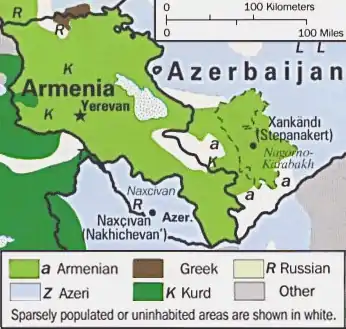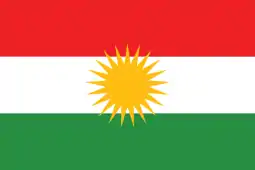Kurds in Armenia
The Kurds in Armenia (Armenian: Քրդերը Հայաստանում, romanized: K'rdery Hayastanum, Kurdish: Kurdên Ermenistanê) form a major part of the historically significant Kurdish population in the post-Soviet space, and live mainly in the western parts of Armenia. The Kurds of the former USSR first began writing Kurdish in the Armenian alphabet during the NEP era in the 1920s, followed by Latin in 1927, then Cyrillic in 1945, and now in both Cyrillic and Latin.[1]
| Languages | |
|---|---|
| Kurdish (Kurmanji), Armenian, Russian |
 |

In line with the policy of korenizatsiya, the Soviet government provided the Kurds of Armenia with access to media such as radio, education and press in their native tongue. The Soviet Armenian authorities established the Kurdish newspaper Riya Teze (The New Path), as well as a Kurdish radio broadcast from Yerevan. The first Kurdish film, Zare, was produced by Armenkino in 1926, and the first Kurdish novel, The Kurdish Shepherd (Şivanê Kurmanca) by Arab Shamilov, was published in Yerevan in 1935. There is a Kurdish Department in the Yerevan State Institute of Oriental Studies.[1]
Kurds in Armenia
The historically suspicious treatment from Armenia toward local Kurds, especially Muslim Kurds, is best explained as a reaction to the fact that some Kurdish tribes in (what was then) Western Armenia participated along with the Turks of the Ottoman Empire during the deportation and genocide of the Armenian populations during the World War I.
In the First Republic of Armenia of 1918–1920, the Kurds received political rights: a Kurdish representative elected to the Armenian parliament, some Kurds became officers of the Armenian Army and organized Kurdish volunteer units.[2]
During the Soviet period a large amount of Kurdish literature was published in Armenia, national schools and radio were opened. According to the Great Soviet Encyclopedia, Soviet Armenia was the main center of Kurdish literature.[3] In 1925 more than fifty schools were opened for the Kurds of Armenia.[4]
In 1937, during the period of Stalinism, many Kurds in Armenia, along with Kurds in Azerbaijan, became victims of forced migration, and were forcibly deported to Kazakhstan.[5][6]
In the period between 1992-94 the Kurdish minority of Lachin and Kelbajar districts of Azerbaijan was forced to flee due to the Armenian invasion during the First Nagorno-Karabakh War.[7]
According to the director of the Center of Kurdish research, the situation with Kurds in Armenia today is normal and there is not any open intolerance.[8] The Election Code of Armenia reserves one seat in the parliament to the representative of the Kurdish minority.[9]
Demographics
| Province | 2001[10] | 2011[11] | ||
|---|---|---|---|---|
| Number | % | Number | % | |
| Armenia | 42,139 | 1.3% | 37,470 | 1.2% |
| Armavir | 17,793 | 6.4% | 17,063 | 6.4% |
| Aragatsotn | 7,251 | 5.2% | 7,090 | 5.3% |
| Ararat | 5,972 | 2.2% | 5,001 | 1.9% |
| Yerevan | 4,825 | 0.4% | 3,361 | 0.3% |
| Kotayk | 4,326 | 1.6% | 3,305 | 1.3% |
| Shirak | 981 | 0.3% | 763 | 0.3% |
| Lori | 802 | 0.3% | 663 | 0.3% |
| Gegharkunik | 124 | 0.1% | 114 | 0% |
| Tavush | 60 | 0% | 44 | 0% |
| Syunik | 4 | 0% | 26 | 0% |
| Vayots Dzor | 1 | 0% | 10 | 0% |
Kurdish-Armenian cultural relations
Prominent Armenian composer Komitas collected many Armenian, Kurdish, and Turkish folk songs,[12] and in 1897 he got a degree in Kurdish Music Studies at Frederick William University in Berlin.
Armenian poet Hovhannes Shiraz used the motives of Kurdish legend in his famous poem "Siamanto and Khjezare".
Prominent Kurds of Armenia
- Najm ad-Din Ayyub and his brother, Shirkuh, who were born near the ancient city of Dvin (near the present-day village of the same name). Ayyub's son Saladin[13][14] would establish a dynasty under his father's name and led the Islamic opposition to the Franks and other European Crusaders in the Levant.
See also
- Armenian–Kurdish relations
- Armenian Genocide
- Hamidiye (cavalry)
- Qulp (Kurdish Emirate in Armavir & Aragatsotn)
- Yazidis in Armenia
References
- Leezenberg, Michiel (2015). "Soviet Kurdology and Kurdish Orientalism". In Kemper, Michael; Conermann, Stephan (eds.). The Heritage of Soviet Oriental Studies. London: Routledge. pp. 89–90. ISBN 9780415838207.
- "Гажар Аскеров КУРДСКАЯ ДИАСПОРА". Archived from the original on 2007-11-20. Retrieved 2007-09-28.
- Kurds at Great Soviet Encyclopedia
- Encyclopedia of World Cultures - P 225. by David Levinson
- "(McDowall - A Modern History of the Kurds, page 492)"
- Kurdish Culture and Society: An Annotated Bibliography - P. 22. by Lokman I. Meho, Kelly L. Maglaughlin
- A People without a country : the Kurds and Kurdistan. Chaliand, Gérard, 1934-, Ghassemlou, Abdul Rahman. (Revised and updated ed.). London: Zed Press. 1993. p. 203. ISBN 1856491943. OCLC 28577923.CS1 maint: others (link)
- Шакро Мгои: «После распада СССР многие курды так и не получили гражданства России»/ Noev Kovcheg, #13, 2006
- "DocumentView". www.arlis.am. Retrieved 2018-01-25.
- "Ethnic composition: 2001 census". Retrieved 23 August 2018.
- "Armenia ethnicity 2011".
- Petsche, Johanna (2015). Gurdjieff and Music: The Gurdjieff/de Hartmann Piano Music and Its Esoteric. p. 121.
- "Encyclopedia of World Biography on Saladin". Retrieved 2008-08-20.
- The medieval historian Ibn Athir relates a passage from another commander: "...both you and Saladin are Kurds and you will not let power pass into the hands of the Turks." Minorsky (1957).
